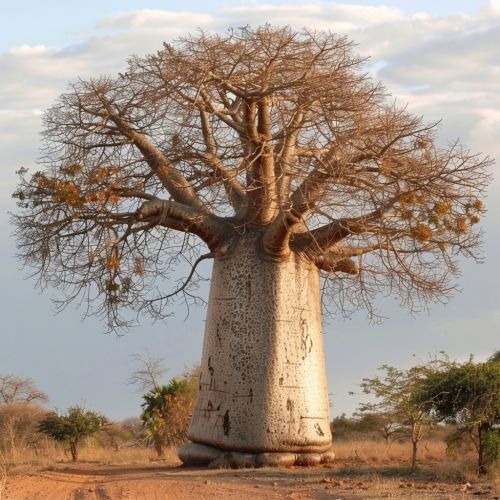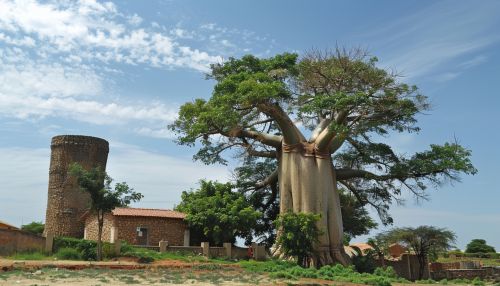Baobab tree
Introduction
The Baobab tree is a unique species of tree native to the African continent, Australia, and the Arabian Peninsula. Known for its distinctive shape, the Baobab tree is often referred to as the "upside-down tree" due to its unusual appearance, with branches that look like roots reaching up into the sky.
Taxonomy and Naming
Baobab trees belong to the genus Adansonia, a group of nine species of tree within the Malvaceae family. The genus was named after the French naturalist Michel Adanson, who first described the Baobab tree during his exploration of Senegal in the 18th century. The term "Baobab" is derived from the Arabic word "bu hibab", which translates to "fruit with many seeds".
Description
Baobab trees are known for their massive size and unique appearance. They can reach heights of up to 30 meters and have trunk diameters of up to 11 meters. The trunk of the Baobab tree is bottle-shaped and can store up to 120,000 liters of water, an adaptation that allows the tree to survive in arid environments.


The bark of the Baobab tree is smooth and greyish in color. It is fire resistant and can regenerate if damaged, providing the tree with protection against wildfires. The leaves of the Baobab tree are palmate and divided into 5-7 finger-like leaflets.
The Baobab tree produces large, pendulous flowers that are white or cream in color. These flowers bloom at night and are pollinated by fruit bats. The fruit of the Baobab tree is a large, oval pod that contains a pulp rich in vitamin C and numerous small black seeds.
Distribution and Habitat
Baobab trees are found in a variety of habitats across the African continent, from the arid savannas of the Sahel to the tropical rainforests of Madagascar. They are also found in Australia's Kimberley region and on the Arabian Peninsula.
The Baobab tree is well adapted to life in arid environments. Its large trunk can store water during the rainy season, allowing it to survive periods of drought. The tree's deep root system also allows it to access groundwater.
Ecological Importance
The Baobab tree plays a crucial role in its ecosystem. Its flowers provide nectar for fruit bats and other pollinators, while its fruit is a food source for various animals, including elephants, baboons, and monkeys. The tree's bark is also used by elephants as a source of water during dry periods.
The Baobab tree also provides habitat for a variety of bird species, including weavers, hornbills, and parrots. In addition, the tree's hollow trunks often serve as nesting sites for bees.
Cultural Significance
The Baobab tree holds significant cultural importance in many African societies. It is often considered a symbol of strength and endurance, and many local myths and legends revolve around the tree. In some cultures, the Baobab tree is believed to possess magical properties and is used in traditional medicine.
Conservation
Despite their importance, Baobab trees are facing numerous threats. Habitat loss due to agriculture and urbanization is a major concern, as is the impact of climate change. In recent years, there have been reports of widespread Baobab tree deaths, possibly linked to changes in rainfall patterns and increasing temperatures.
Conservation efforts are underway to protect the Baobab tree. These include habitat protection, seed collection and propagation, and community education programs.
